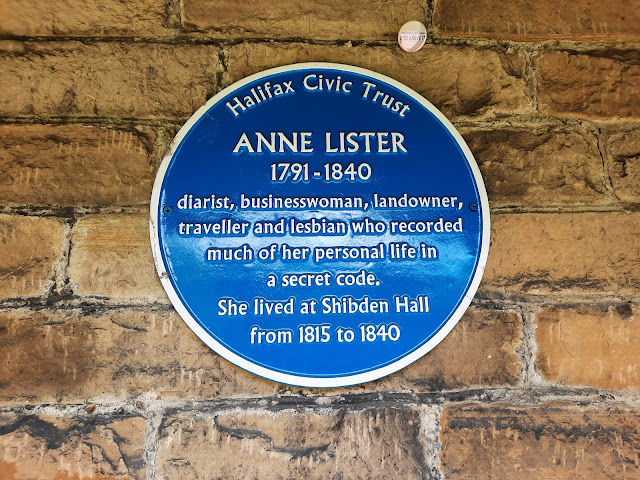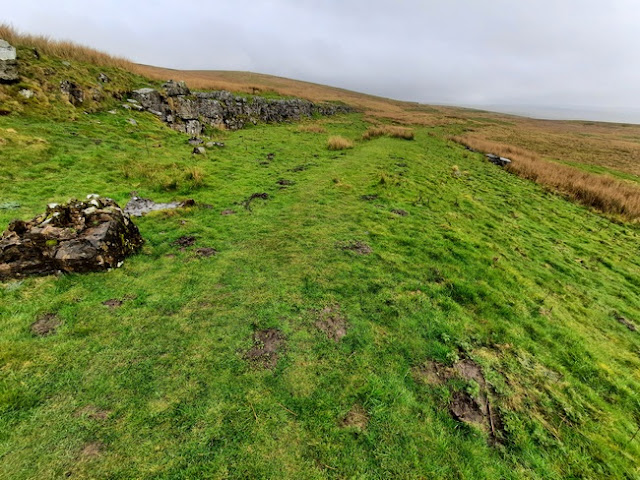Starting Point - Halifax Railway Station. Finishing Point - Shibden Hall. Distance - 1.7 Miles
Shibden Hall dates back to 1420. After passing through a few notable local families it became the home of the Lister family from 1619. Most famously it was the home of Anne Lister from 1815 to 1840. Anne Lister was a businesswoman who kept a diary, details of her lesbian love life were kept in the diary using a code. In recent years these diaries have been the inspiration for the Gentleman Jack TV series.
During Anne's time at Shibden Hall she made several alteration to the estate to enhance the status of the Hall. She developed coal mines on the estate to better exploit coal reserves previously mined by Jeremy Lister from 1775. The lake near the hall was intended to operate a water engine to power one of the mines (supposedly with energy to spare to power a mill, though this didn't work out and a steam engine was employed) and a ventilation shaft can still be seen from one of the mines.
I reached Halifax by train and walked to Shibden Hall. From the corner of Bank Bottom and Charlestown Road a footpath called Old Bank can be reached, this is a former road that was once lined with buildings. Now only a footpath it does still have the stone setts of the earlier roadway.
Below - Painting of Anne Lister (as portrayed in the Gentleman Jack TV series) on the Ring O Bells pub as I passed on Church Street.
Below - Old Bank

The path emerges on to Beacon Hill Road, across the road another path is signposted to Shibden Hall. This appears on Open Street Maps but not on Google Maps and links to what the old map shows as Miss Lister's Road. Miss Lister's Road no longer links to Lister Road, it seems it was diverted as the fireclay works expanded. This path leads to another that skirts Cunnery Wood which was part of the Shibden Hall estate.
Below - A surviving part of Miss Lister's Road

Below - A view across Halifax.
On the edge of Cunnery Wood the ventilation shaft of Walker Pit can be seen. Walker Pit was opened in 1835, it was named after Anne Lister's partner Anne Walker. To draw fresh air through the coal workings a fire would be lit at the base of the chimney. More details about the mining on the Shibden estate can be found on the
Packed With Potential website.
Below - Building next to the ventilation shaft.
Walker Pit only operated for a short time, it was found that the Rawsons had stolen a lot of the Lister coal (as mentioned in the TV series). Anne Lister went on to develop pits further east on the estate.
The old maps show gardens in Cunnery Wood which no longer survive, though remnants of a couple of buildings in the gardens can be seen. A pond close to Shibden Hall Road (shown on the old map as Lister's Road) survives.
Below - One of the buildings from the former gardens in Cunnery Wood.
Below - Remains of another building from the gardens in Cunnery Wood with ornamental collumns.
Below - Tunnel under Shibden Hall Road linking the former gardens in Cunnery Wood to the hall.
Below - Shibden Hall seen from the terraced gardens. The tower was added by Anne Lister to make the former Tudor manor house a grand house worthy of an important family.
Following the bankruptcy of John Lister the estate became a public park in 1926 with the hall becoming a museum in 1934. Many of the rooms have been restored to their appearance under Anne Lister's ownership.
Calderdale Museums website.
Below - Blue plaque dedicated to Anne Lister.
Below - Interior views at Shibden Hall.
Below - The stable and carriage sheds next to the hall.
Below - Carriages on display.
In the buildings around the courtyard exhibitions were established displaying various local trades as the West Yorkshire Folk Museum.
Below - A reconstructed pub interior.
Below - A basket makers.
Below - The kitchen on a estate manager's home, note the oatcake (or havercake) rack on the ceiling.
Below - A wheelwright
Below - A horse gin. Horse gins would have been used to wind coal from the Lister mines, they were also put to agricultural uses.
Below - A brewery.
After my visit to the hall and the cafe beside the lake in the park I returned to Halifax by the same route.
Concluding the Anne Lister story on my walk, her final burial place was in Halifax Minster which I passed on my way between Halifax and Shibden Hall. She died in Georgia following an insect bite in 1840 and was buried at the church with crowds lining the route I had just taken.
Her grave was lost under modifications to the church made in the 1870s and only recently rediscovered. The grave stone has a piece cut out of it from a ventilation system but is on display with displays to fill in for the lost detail and provide more information about it.
Below - Anne Lister's grave in Halifax Minster.
Below - Another site close to the route with more content related to Anne Lister is the Calderdale Industrial Museum which has information about her mining activities in the mining displays and has books on sale on the subject. More information can be found on the
museum website. The museum opens on Saturdays and Thursdays in the school holidays. This is on the edge of the spectacular Piece Hall trading hall. Piece Hall also has a room that belonged to Anne Walker's family and this is marked with a sign in the window.
Below - Calderdale Industrial Museum.































































